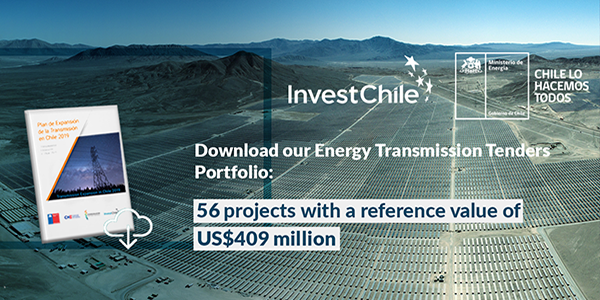The aim is for 70% of the electricity consumed in the country to be from sources such as photovoltaic or wind energy by 2050; this is in addition to the announced decarbonization plan.

The availability of renewable resources such as the sun, wind, water and geothermal energy, which are distributed homogeneously around Chile, has helped to position it as one of the most advanced countries in this field, both regionally and internationally. This also reflects a long-term energy policy, the reduction in the cost of renewable technologies, greater awareness on the part of consumers who have chosen to use sustainable energy and a private sector willing to invest massively in these technologies.
“In 2010-2011, Chile had an installed capacity of non-conventional renewable energies (NCREs) of around 500 MW but, in just five years, we have been able to make the leap to more than 5,000 MW of installed power. This has allowed us to gain visibility in the world and we have taken the pole position and leadership at the regional level,” points out José Ignacio Escobar, president of the Chilean Association of Renewable Energies (ACERA). He notes that “Chile constantly appears in the top positions in the E&Y and Bloomberg indices on investment in renewable energy.”
“We have privileged natural conditions,” says Energy Minister Juan Carlos Jobet, “but the development of energy projects has been possible thanks to our recognized institutional and economic stability, which allows us to offer developers the certainty [they need] to invest in these new sources of generation.” He adds that an appropriate regulatory framework was designed to permit the incorporation of sources of this type in a competitive and sustainable manner. The Minister also explains that, in another key factor, the cost of the technologies has shown a marked drop recently and “each year, we see new price lows in the development of projects.”
The challenge of being one of the leading countries in NCRE, with a safe, efficient and sustainable electricity matrix, is not only a matter of positioning in the rankings. It is complemented by the plan that has been announced to decarbonize the matrix (which envisages the shutting down of eight coal-fired plants over the next five years and, as its ultimate goal, the closure of the country’s remaining thermoelectric generators by 2040). The aim is that, by 2050, 70% of the electricity consumed in Chile will be generated from clean renewable sources and large hydroelectric plants.
Experts warn that, in order to achieve this, it will be necessary to go by stages, the most immediate of which is the 20/25 target that, by 2025, the annual share of NCREs will reach 20%. According to Escobar, “in both cases, I have no doubt that the targets and ambitions will be surpassed. According to our estimates, Chile can perfectly well reach 90% of renewable energies by 2030 of which two-thirds would be NCRE.”
Minister Jobet confirms Escobar’s estimates, indicating that “in 2018, renewables accounted for 46% of electricity production. Exceeding the target of 70% by 2050 certainly implies a challenge for all the sector as regards new energy projects.” He points out, however, that different studies by both the Energy Ministry and the private sector indicate that, given the level of integration of renewable energies expected in the future and the commitment to decarbonization that generators have signed with the Energy Ministry, it is likely that the target will be achieved earlier and be well surpassed by 2050. Minister Jobet adds that achieving the country’s decarbonization and NCRE targets will call for collaboration from all the players, in both the public and private sectors, in order to progress in the implementation of a series of cost-efficient measures such as the greater integration of renewables for both electrical and thermal uses, energy efficiency measures, the integration of efficient and sustainable transport and the incorporation of new energy solutions.
At present, the most commonly used NCRE technologies in Chile are solar photovoltaic technology, followed by wind technology and, in third place, mini run-of-the-river hydro plants. However, there is also great interest, in both the public and private sectors, in boosting others such as biotechnology, geothermal power and, soon, concentrated solar power.
To learn more about renewable energy investment opportunities in Chile, see the following article.
Source: Pulso



%2017.11.51.png)

